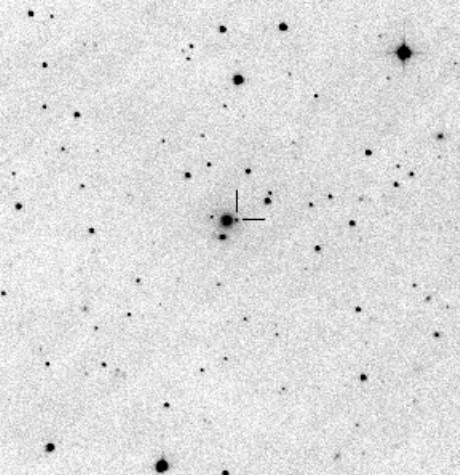SN 2011dv (A.R. 16 12 04.61, Dec. +14 12 33.2) scoperta il 28 giugno 2011 nella galassia NGC 6078 (offset 13W 0N), magnitudine 18.2, tipo Ia.
SN scoperta da F. Ciabattari con il telescopio Newton da 50cm dell'Osservatorio di Monte Agliale (Lucca).
NGC 6078 è una galassia ellittica nella costellazione dell'Ercole, distante 130 Mpc, magnitudine 14.7.

Electronic Telegram No. 2755
Central Bureau for Astronomical Telegrams
INTERNATIONAL ASTRONOMICAL UNION
CBAT Director: Daniel W. E. Green; Hoffman Lab 209; Harvard University;
20 Oxford St.; Cambridge, MA 02138; U.S.A.
e-mail: Questo indirizzo e-mail è protetto dallo spam bot. Abilita Javascript per vederlo. (alternate Questo indirizzo e-mail è protetto dallo spam bot. Abilita Javascript per vederlo. )
URL http://www.cbat.eps.harvard.edu/index.html
Prepared using the Tamkin Foundation Computer Network
SUPERNOVA 2011dv IN NGC 6078 = PSN J16120400+1412330
F. Ciabattari, Borgo a Mozzano, Italy, reports the discovery of a point-
like object (mag 16.2) on unfiltered CCD images (limiting magnitude 19.2)
obtained on June 28.86 UT with a 0.5-m Newtonian telescope in the course of
the Italian Supernovae Search Project, the new object being located at R.A. =
16h12m04s.62, Decl. = +14d12'33".2 (equinox 2000.0; astrometry with respect to
UCAC-2 stars), which is 13" west of the center of the galaxy NGC 6078. The
variable was designated PSN J16120400+1412330 when posted on the Central
Bureau's TOCP webpage and is here designated SN 2011dv based on the
spectroscopic confirmation reported below. Additional magnitudes for 2011dv
as provided by Ciabattari: 1992 Apr. 30, [20.3 (Palomar Sky Survey, J plate);
1994 June 8, [20.3 (Palomar Sky Survey, F plate); 2010 June, [19.1 (images
taken by Ciabattari); 2011 June 29.98 UT, 16.0 (A. Dimai, Cortina d'Ampezzo,
Italy; and S. Leonini, Siena, Italy; remotely using the GRAS-7 PlaneWave
43-cm CDK telescope in Spain).
D. C. Leonard, San Diego State University; J. Moustakas, University of
California at San Diego; B. J. Swift and D. McCarthy, University of Arizona;
V. Bailey, E. Carrico, A. Carter, E. Chui, E. Douglas, E. Eggeman, R. Goldberg,
R. Grant, K. Hartman, J. Hellerstein, E. Hooper, C. Horlick-Cruz, L. Hunter, T.
Jiles, E. D. Johnson, K. Kumar, L. Lappe, J. Lee, W. Lee, F. Marsh, G. Mehta,
P. Miller, R. Rampalli, J. Reed, K. Rice, H. Saldivar, M. Salgado-Flores, A.
Schlingman, W. F. Schlingman, W. M. Schlingman, S. Scibelli, K. Sinclair, I.
Steincamp, N. Stock, N. Todd, L. L. Aizpuru Vargas, S. Yamanaka, and E.
Zachary, 2011 Advanced Teen Astronomy Camp, report that inspection of a
low-dispersion optical spectrum (range 370-690 nm) of PSN J16120400+1412330 =
SN 2011dv, obtained with the 2.3-m Bok telescope (+ Boller & Chivens
spectrograph) at Steward Observatory on June 30 UT, shows it to be a normal
type-Ia supernova near maximum light. Cross-correlation with a library of
supernova spectra using the "Supernova Identification" code (SNID; Blondin and
Tonry 2007, Ap.J. 666, 1024) finds good matches with near-maximum (2 +/- 6
days) template spectra of SN 1992A and SN 2002bo. Adopting the NASA/IPAC
Extragalactic Database recession velocity for NGC 6078 of 9378 km/s (Falco et
al. 1999, PASP 111, 438), the maximum absorption in the Si II line (rest
635.5 nm) is blueshifted by approximately 13600 km/s.
D. D. Balam, Dominion Astrophysical Observatory, National Research Council
of Canada (NRCC); M. L. Graham, Las Cumbres Observatory Global Telescope,
University of California at Santa Barbara; E. Y. Hsiao, Lawrence Berkeley
Laboratory; and D. W. E. Green, Harvard University, report that a spectrogram
(range 389-725 nm., resolution 0.3 nm) of PSN J16120400+1412330 = SN 2011dv,
obtained on June 30.27 UT with the 1.82-m Plaskett Telescope of the NRCC,
shows it to be a type-Ia supernova about five days past maximum light.
Cross-correlation with a library of supernova spectra using the SNID code
indicates that 2011dv is most similar to the type-Ia supernova 2006gz at
five days past maximum light.
NOTE: These 'Central Bureau Electronic Telegrams' are sometimes
superseded by text appearing later in the printed IAU Circulars.
(C) Copyright 2011 CBAT
2011 June 30 (CBET 2755) Daniel W. E. Green




